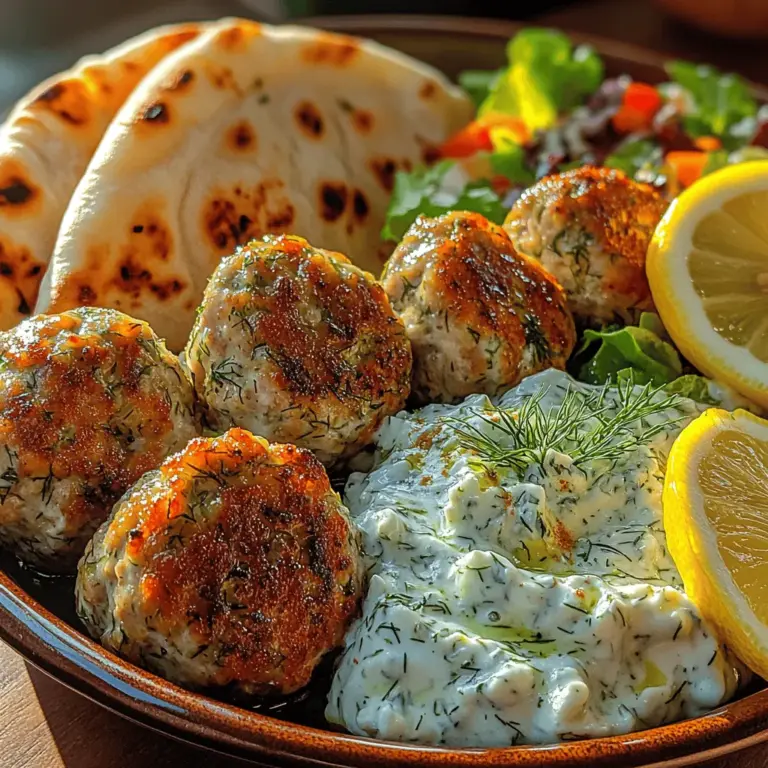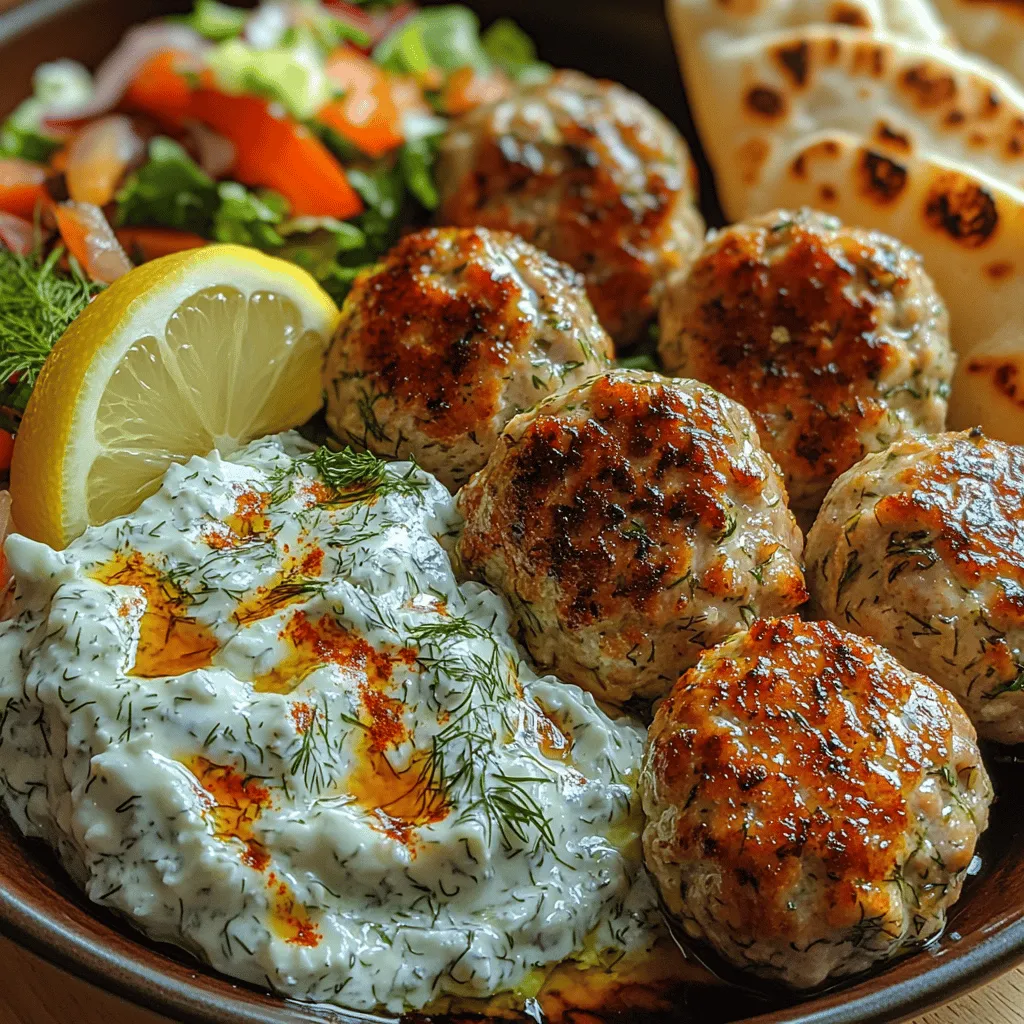Introduction to Mediterranean Cuisine and Greek Turkey Meatballs
Mediterranean cuisine has long been celebrated for its vibrant flavors, rich history, and numerous health benefits. This diverse culinary tradition spans the countries lining the Mediterranean Sea, incorporating an array of ingredients such as fresh vegetables, grains, legumes, fish, and lean meats. The Mediterranean diet is not just a diet; it’s a lifestyle that promotes the consumption of wholesome foods and emphasizes the importance of communal meals. Among the many delightful dishes that this cuisine offers, Greek Turkey Meatballs stand out as a flavorful and nutritious option that captures the essence of Mediterranean cooking.
These succulent meatballs, complemented by a refreshing Tzatziki sauce, are perfect for a family dinner or a gathering with friends. They offer a creative twist on traditional meatballs by substituting ground turkey for the more commonly used beef or pork. This substitution not only makes the dish lighter but also aligns with the Mediterranean diet’s focus on lean proteins. In this article, we will guide you through the culinary journey of crafting these delicious Greek Turkey Meatballs, highlighting their ingredients, preparation methods, and nutritional benefits.
Understanding the Ingredients
Exploring the Key Components of Greek Turkey Meatballs
When it comes to making Greek Turkey Meatballs, the choice of ingredients is crucial. Each component plays a vital role in creating a dish that is both flavorful and nutritious. Let’s take a closer look at the main ingredients used in this recipe and their nutritional significance.
– Ground Turkey: At the heart of our meatballs is ground turkey, a lean protein source that is lower in fat compared to beef or pork. Ground turkey not only keeps the meatballs moist and flavorful but also packs a punch when it comes to protein content. This makes it an excellent choice for those looking to maintain a healthy diet without sacrificing flavor.
– Whole Wheat Breadcrumbs: Instead of traditional white breadcrumbs, this recipe calls for whole wheat breadcrumbs, which add fiber and a hearty texture to the meatballs. Whole grains are an essential part of a balanced diet, contributing to digestive health and providing sustained energy levels.
– Parmesan Cheese: A sprinkle of Parmesan cheese elevates the flavor of the meatballs, adding a savory depth that complements the other ingredients. Rich in calcium and protein, Parmesan not only enhances taste but also contributes to the dish’s nutritional profile.
– Fresh Herbs: The use of fresh herbs like parsley and dill is a hallmark of Greek cuisine. These vibrant herbs not only add a burst of color and flavor to the meatballs but also bring a wealth of health benefits. Parsley is known for its antioxidant properties, while dill has been linked to digestive health.
– Spices: To round out the flavor profile, spices such as oregano, salt, and pepper are essential. Oregano, a staple in Mediterranean cooking, is rich in antioxidants and adds a warm, earthy note to the dish. The right balance of seasoning is crucial for achieving the perfect taste.
Delving into Tzatziki Sauce Ingredients
No Greek meal is complete without Tzatziki sauce—a creamy, refreshing condiment that pairs beautifully with the meatballs. Let’s break down the key components of this beloved sauce and see how each ingredient contributes to its delightful taste and texture.
– Greek Yogurt: The foundation of Tzatziki, Greek yogurt is not only thick and creamy but also rich in probiotics, which promote gut health. Its high protein content makes it a substantial base for the sauce, offering a satisfying texture that complements the meatballs perfectly.
– Cucumber: Fresh cucumber adds a refreshing crunch to the Tzatziki sauce. Known for its hydrating properties, cucumber also brings a lightness to the dish, balancing the creaminess of the yogurt. Grating the cucumber and squeezing out excess moisture ensures that the sauce doesn’t become watery.
– Garlic and Dill: These aromatic ingredients infuse the Tzatziki with bold flavors. Garlic adds a pungent kick, while dill contributes a distinct herby note that is synonymous with Mediterranean cuisine. Together, they create a harmonious blend that elevates the sauce.
– Lemon Juice: A splash of lemon juice is essential for adding acidity to the Tzatziki, balancing out the creamy yogurt and enhancing the overall flavor. The bright citrus notes brighten the dish and provide a refreshing finish.
Step-by-Step Guide to Creating Greek Turkey Meatballs
Creating Greek Turkey Meatballs might seem daunting, but with a few simple steps, you’ll be able to whip up a delicious meal that’s sure to impress your family and friends. Here’s a detailed guide to crafting the perfect meatball mixture and preparing to cook them.
Crafting the Perfect Meatball Mixture
The first step in making Greek Turkey Meatballs is to gather all of your ingredients. Having everything at hand will streamline the process and ensure you don’t miss any key components.
Mixing Techniques
1. Combine Ingredients: In a large mixing bowl, combine the ground turkey, whole wheat breadcrumbs, grated Parmesan cheese, finely chopped parsley, chopped dill, and spices (oregano, salt, and pepper). It’s important to mix these ingredients gently to avoid overmixing, which can lead to tough meatballs.
2. Add Moisture: For added moisture and flavor, consider incorporating a beaten egg into the mixture. This not only helps bind the ingredients but also contributes to the tenderness of the meatballs. If you prefer a lighter version, you can skip the egg and ensure the turkey is moist enough by using a higher fat content ground turkey.
3. Mix with Care: Using your hands, gently combine the ingredients until just incorporated. It’s best to mix until everything is evenly distributed without compacting the mixture too much. Overmixing can produce dense meatballs rather than the tender, juicy texture we desire.
4. Taste Test: Before shaping into meatballs, consider cooking a small spoonful of the mixture in a skillet to test for seasoning. Adjust salt, pepper, and herbs to your taste, ensuring the flavors are just right.
Shaping and Cooking the Meatballs
Once you have your meatball mixture ready, it’s time to shape and cook them.
1. Shape the Meatballs: Wet your hands slightly to prevent sticking, and take a small portion of the mixture (about 1.5 inches in diameter) to shape into a ball. Place each formed meatball on a baking sheet lined with parchment paper. This will make transferring them to the cooking surface much easier later on.
2. Cooking Methods: There are several ways to cook your Greek Turkey Meatballs, depending on your preference. You can bake them in the oven, pan-fry them in a skillet, or even grill them for a smoky flavor. Each method has its benefits and will yield delicious results.
– Baking: Preheat your oven to 400°F (200°C). Arrange the meatballs on a baking sheet and bake for about 20-25 minutes, or until they are cooked through and golden brown. Baking is a healthier option and allows for even cooking without the need for added oil.
– Pan-Frying: Heat a tablespoon of olive oil in a skillet over medium heat. Add the meatballs in batches, being careful not to overcrowd the pan. Cook for about 6-8 minutes on each side, or until browned and cooked through. This method gives the meatballs a beautiful crust and adds to their flavor.
– Grilling: Preheat your grill to medium-high heat. Place the meatballs directly on the grill grates and cook for about 10-12 minutes, turning occasionally until fully cooked. Grilling imparts a wonderful smoky flavor that enhances the Mediterranean experience.
3. Check for Doneness: Regardless of the cooking method you choose, ensure the meatballs reach an internal temperature of 165°F (74°C) for safe consumption. Using a meat thermometer is the best way to confirm they are fully cooked.
With these steps, you’re well on your way to creating delectable Greek Turkey Meatballs that are bursting with flavor and nutrition. In the following sections, we will dive deeper into preparing the Tzatziki sauce, serving suggestions, and tips to ensure your dish is a resounding success. Stay tuned for an exciting culinary adventure that celebrates the rich traditions of Mediterranean cooking.
Instructions for Forming and Cooking the Greek Turkey Meatballs
To create the perfect Greek turkey meatballs, the process of forming and cooking them is crucial for achieving a delightful golden crust while maintaining a juicy interior. Begin by preheating your oven to 400°F (200°C) if you plan to bake the meatballs.
Forming the Meatballs
1. Mix Ingredients: In a large mixing bowl, combine the ground turkey with the breadcrumbs, finely chopped onions, minced garlic, chopped fresh herbs (such as parsley and mint), salt, and pepper. Mix gently, being careful not to overwork the meat to keep the meatballs tender.
2. Shape Meatballs: Use your hands to scoop out a portion of the mixture, approximately 1.5 inches in diameter. Roll the mixture between your palms to form a smooth ball. Repeat until all of the mixture is shaped into meatballs, placing them on a tray lined with parchment paper.
Cooking Methods: Pan-Searing vs. Baking
Both pan-searing and baking are excellent cooking methods for Greek turkey meatballs, each offering unique benefits:
– Pan-Searing: This method involves cooking the meatballs in a skillet with a drizzle of olive oil over medium heat. Sear the meatballs for about 4-5 minutes on each side until they develop a rich, golden crust. This method enhances the flavor through caramelization, providing a crispy exterior while keeping the inside moist and tender.
– Baking: Baking the meatballs in the oven is a healthier alternative that requires less oil. Arrange the shaped meatballs on a baking sheet and bake them for approximately 20-25 minutes, turning halfway through for even cooking. Baking allows the meatballs to cook evenly and reduces the amount of added fat, making it a great option for a lighter meal.
Once cooked, the meatballs should reach an internal temperature of 165°F (74°C). Whether you choose to pan-sear or bake, the ultimate goal is to achieve that ideal golden crust while ensuring they remain juicy.
Preparing the Tzatziki Sauce
A well-balanced tzatziki sauce is the perfect accompaniment to Greek turkey meatballs, adding a refreshing and tangy flavor. Follow these step-by-step instructions to create a delicious tzatziki sauce:
1. Drain the Cucumber: Start with one medium cucumber. Grate it using a box grater and place the grated cucumber in a clean kitchen towel or cheesecloth. Squeeze out as much excess moisture as possible. This step is crucial, as it prevents the tzatziki from becoming watery.
2. Combine Ingredients: In a medium bowl, mix the drained cucumber with 1 cup of plain Greek yogurt, 2 tablespoons of extra virgin olive oil, 1 tablespoon of red wine vinegar, 1-2 cloves of minced garlic (adjust based on preference), and a pinch of salt. Stir until all ingredients are well combined.
3. Chill for Flavor Development: Cover the bowl and refrigerate the tzatziki sauce for at least 30 minutes before serving. Chilling allows the flavors to meld together, enhancing the overall taste of the sauce.
Serving Suggestions for Greek Turkey Meatballs
To elevate your dining experience, consider the following plating ideas and serving suggestions for your Greek turkey meatballs with tzatziki sauce:
Plating Ideas
– Arrange the meatballs on a large serving platter, drizzling some tzatziki sauce over them for a beautiful presentation.
– Create a small bowl of tzatziki sauce at the center for dipping, surrounded by the meatballs.
Creative Serving Suggestions
– Pita Bread: Serve the meatballs alongside warm pita bread, perfect for scooping up the meatballs and sauce.
– Greek Salad: Complement the dish with a refreshing Greek salad made of tomatoes, cucumbers, olives, and feta cheese drizzled with olive oil and lemon juice.
– Roasted Vegetables: Offer a side of roasted seasonal vegetables like bell peppers, zucchini, and eggplant, which enhance the Mediterranean theme of the meal.
Meal Presentation Tips
– Incorporate garnishes such as fresh herbs or lemon wedges on the platter to add a pop of color and freshness.
– Consider using a rustic wooden board for a charming, Mediterranean-inspired presentation.
Nutritional Benefits of Greek Turkey Meatballs and Tzatziki
This Greek turkey meatball recipe not only tantalizes your taste buds but also provides numerous health benefits due to its wholesome ingredients:
Lean Protein
Turkey is a fantastic source of lean protein, essential for muscle growth and repair. It is lower in fat than many other meats, making it a great choice for health-conscious eaters.
Healthy Fats
The inclusion of extra virgin olive oil and Greek yogurt adds healthy fats to the meal. Olive oil is rich in monounsaturated fats, known to promote heart health and reduce inflammation. Greek yogurt provides probiotics, which are beneficial for digestive health.
Vitamins and Minerals
The fresh herbs used in the meatballs and tzatziki sauce, such as parsley and mint, are packed with vitamins and antioxidants. Additionally, the cucumbers in the tzatziki are hydrating and low in calories, making this dish a nourishing choice.
Cultural Significance of Greek Cuisine
Greek cuisine is rich in tradition and history, with meatballs (known as “keftedes”) being a beloved staple. These flavorful morsels have been enjoyed for centuries, often served at family gatherings and celebrations.
The Role of Meatballs in Greek Tradition
Keftedes are not only a delicious dish but also represent the communal spirit of Greek dining. They are typically made from various meats, including beef, pork, and lamb, but turkey is a modern, health-conscious twist that maintains the essence of the dish.
Culinary Traditions
Greek meatballs differ from other meatball recipes around the world through their unique blend of spices and herbs, such as mint, cinnamon, and allspice, which add a distinctive flavor profile. This recipe showcases the Mediterranean approach to cooking, emphasizing fresh ingredients and robust flavors.
Conclusion: Enjoying Mediterranean Delight at Home
Creating Greek Turkey Meatballs with Tzatziki sauce is a rewarding culinary journey that brings the vibrant flavors of the Mediterranean to your table. This dish not only showcases the versatility of turkey as a lean protein option but also highlights the health benefits of fresh ingredients, making it a wholesome choice for any meal.
As you savor the juicy meatballs paired with the creamy, tangy tzatziki, take a moment to appreciate the cultural significance and rich history behind this beloved dish. Whether enjoyed at a family gathering or as a satisfying weeknight dinner, these Greek turkey meatballs are sure to impress.
We encourage you to explore more Mediterranean recipes and embrace the healthy cooking practices inspired by this vibrant cuisine. With each bite, you’ll taste the love and tradition of Greek cooking, bringing a piece of the Mediterranean right into your home.



